Building a Custom Computer Desk, Part 2
Will’s build of his dream computer desk continues! This week, Will spends time in Adam’s shop assembling the top of the desk with some biscuit joining, using some tips learned from viewers. And before putting together the table legs, Will gets some practice with welding. (This video was brought to you by Premium memberships on Tested. Learn more about how you can support us with memberships!)
43 thoughts on “Building a Custom Computer Desk, Part 2”
Leave a Reply

One Day Builds
Adam Savage’s One Day Builds: Life-Size Velocirapt…
Adam embarks on one of his most ambitious builds yet: fulfil…

Show And Tell
Adam Savage’s King George Costume!
Adam recently completed a build of the royal St. Edwards cro…
All Eyes On Perserverance – This is Only a Test 58…
We get excited for the Perserverance rover Mars landing happening later today in this week's episode. Jeremy finally watches In and Of Itself, we get hyped for The Last of Us casting, and try to deciper the new Chevy Bolt announcements. Plus, Kishore gets a Pelaton and we wrack our brains around reverse engineering the source code to GTA …

One Day Builds
Mandalorian Blaster Prop Replica Kit Assembly!
Adam and Norm assemble a beautifully machined replica prop k…
House of MCU – This is Only a Test 586 – 2/11/21
The gang gets together to recap their favorite bits from this past weekend's Superb Owl, including the new camera tech used for the broadcast and the best chicken wing recipes. Kishore shares tips for streamlining your streaming services, and Will guests this week to dive into the mind-bending implications of the latest WandaVision episod…

One Day Builds
Adam Savage’s One Day Builds: Royal Crown of Engla…
One of the ways Adam has been getting through lockdown has b…

Making
Adam Savage Tests the AIR Active Filtration Helmet…
Adam unboxes and performs a quick test of this novel new hel…

Making
Weta Workshop’s 3D-Printed Giant Eyeballs!
When Adam visited Weta Workshop early last year, he stopped …

One Day Builds
Adam Savage’s One Day Builds: Wire Storage Solutio…
Adam tackles a shop shelf build that he's been putting off f…
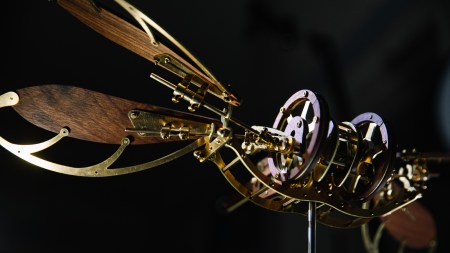
Show And Tell
Mechanical Dragonfly Automata Kit Build and Review
Time for a model kit build! This steampunk-inspired mechanic…






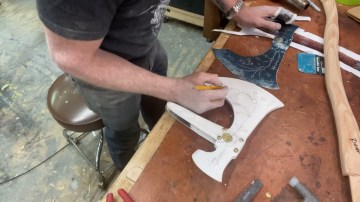
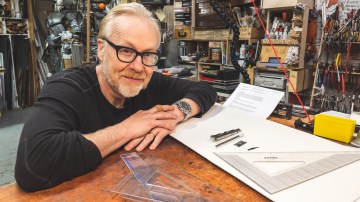
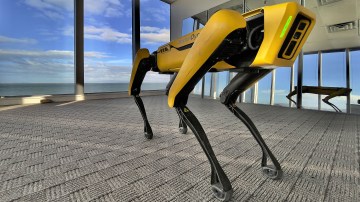
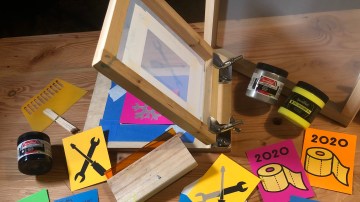
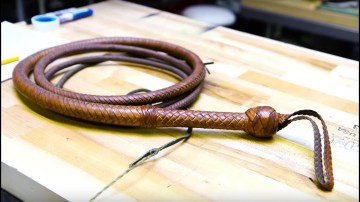
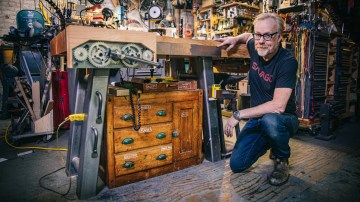


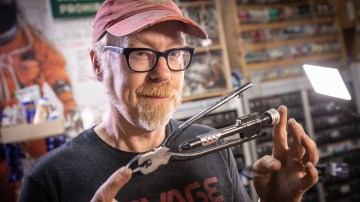
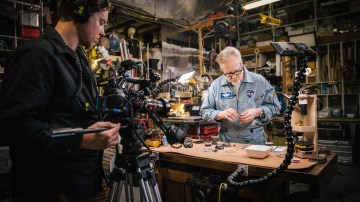
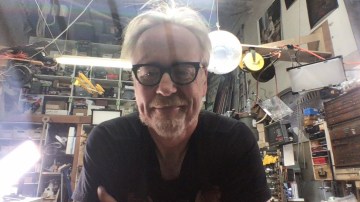

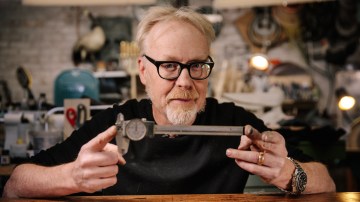
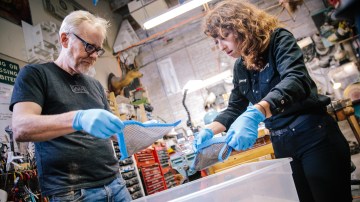
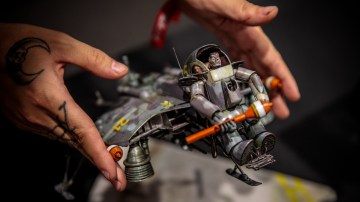
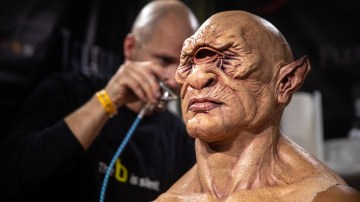




Sweet. Been waiting for the second part!
Hey ,
if you haven’t done the angles yet, drag your pieces over to TechShop, they have a nice big chopsaw for metal, complete with set angles, that would make it much easier to do all those cuts. I used it last week on a project and it made easy work of what I was doing.
I’m sure they have one at M5 you can use, but I’m guessing access to M5 is reliant on Mythbuster filming schedules.
BTW, you made a comment about a watercutter at the end there, you’d definitely do *not* want to use a waterjet to cut anything hollow… 55,000psi man, very dangerous. And even if you were working with solid materials you wouldn’t get a straight cut from it. Since the jet spreads and looses its focus, in thick materials edges cut on the waterjet will go like this /
Nice. Try plaing with the fed rates of the welder, a slower rate might be a bit better untill you get better at it. Remember to just go stedy, maybe use two hands on the handle. Also be careful not to weld the end of the wire to the tip.
Those angles really need to be spot on or you will through the whole thing out. If they are not square, you’re legs might twist. But keep it up. It is starting to really look good. Can’t wait to see the end product.
Yes! Part 2!
I guessed that you would be using a cold saw to make those cuts. I just figured that if Adam has a metal lathe in his shop, that he would also have a cold saw to cut round and square tubing. But, a portable bandsaw will work too. 😉 The cuts won’t be as clean, though..
Please take a little time and practice making some tack welds before you do any final welding, Things will go much smoother if you do..
You could use a linisher or large disc sander to make the angles on your steel good after you cut off the excess. Just make sure your work is well supported if you do this, and the grit and speed on the machine are suitable.
p.s death from hellboy 2?
Cold-saw, that’s the word I was looking for when mentioning the one at TechShop. It leaves such awesomely smooth, straight cuts, but I’ve got no idea if Will has taken the necessary classes to use their metal shop.
I would guess not, considering what we just saw.
Well, he is working on a project in Adam’s shop and it seems he only realized that the handheld bandsaw wasn’t the right tool during filming. Until then there was no reason why he’d go elsewhere.
The whole project is a very interesting watch, but I feel Will has way overdesigned and complicated the desk. It’s a fun thing for sure, but watching this I’m pretty sure there would have been much easier and practical design solutions.
I spy a Jean Giraud space suit! squee! There must be a video with Adam about that project!
I hope this isn’t teaching you to suck eggs, but have you thought about renting the right kind of saw? A good workshop supplier should be able to guide you to the best tool for the job if you show them what you’re trying to achieve. A few dollars renting a chop saw would save you hours struggling with the wrong tools. If you haven’t already, try Googling shop tool rentals for your area.
I would think it would be creepy to work in a shop where everything is watching you, looking around you have the feel of that stormtrooper and the random female head just staring O_o… It would creep me out
Hey
I am very lucky my old man is a 50 year+ boiler maker and he has taught me heaps about welding (but I’m still learning). The best way to weld when starting is to weld flat, if you weld standing welds they can run.
Also for cutting those angles, try a ultra thin cutting disc that will go on an angle grinder. They look like a grinding disc but are 1mm thick and they cut like a hot knife through butter. A bonus on the size steel you are using you shouldn’t have to rotate it. The best thing is to mark the angle with a sharpie, and join the line all the way around (with a right angle) so you can follow it while you are cutting.
This is the cutting discs I am talking about
https://www.youtube.com/watch?v=NYQlF4Glua0
Please be very safe and wear the leather welding jacket and face shield, because they are thin they can snap very easily and can be dangerous.
make sure you clean up
I can’t imagine having all that cool stuff in my shop (props and pool table). For me, learning to weld was a very messy experience. I didn’t realize it at the time but welding and massive amounts of grinding covered everything in my garage with a pretty gnarly layer of dust.
word! Still very interested in the outcome. All those angled cuts and welds are going to come back to bite you, will…
For repeatability and getting everything even, jigs will be your friend. For each angle I’d create a jig to hold the piece, and strap an angle grinder with a cut off wheel to a hinged piece of wood clamped to the jig to make a little chop saw. They are easy to make, and the jig will help to get everything close to your final size and angle. Then some time with the hand held grinder and disc sander will get you spot on.
also for the final assembly of the two leg sides, I’d recommend making a weld fixture that clamps each piece in the proper orientation. basically a scrap piece of plywood with 2×4 blocks screwed to it to create slots for the tube to sit constrained. if you want to go all out, add some toggle clamps to hold the pieces down as well. once the first one is fixtured and set, trace it with a sharpie on the board to help align the second side. This will help you to ensure both sides turn out the same. also provides a nice place to note the weld order as well, since the welds will distort the frame as you go it’ll help to do them in the same order on both sides.
Will,
I recently learned how to MIG weld for a sculpture class and was also super jumpy when it first sparks. I found it really helpful to have your spare hand underneath the welding gun just above the trigger so it can support the gun and you’ll be more stable when it starts to spark. So you’ve got one hand resting there and the gun sort of pivots on top of it.
It also helps you to keep the tip close to the material you’re trying to weld. When the wire comes out it’ll push back against you and in my early days I would end up with a long bit of wire out of the gun that I’d then have to snip off before I could weld again.
Neat video. Glad you’re showing that it’s okay to learn and take your time, even if it’s frustrating to folks who already know how and are screaming at their screens…
For the angles, maybe it would be a good idea to make a jig pattern on a scrap piece of plywood or MDF? Lay it out EXACTLY like you want, using blocks to hold the metal tubing in place, and then grind/cut the angles to fit that. You might even be able to weld the starter side seams while it’s in the jig, then flip it over to finish? Both legs are symmetrical to each other, so your jig would work for both?
At 9:00, those angles look scary. Have you considered that the ones on the back (left side of the drawing) go further than the desk top? Won’t they, you know, ruin your wall if you put the desk against it?
Yeah, I always cringe a bit when I see all those GREAT movie props in the background, knowing that they probably are getting routinely dusted with detritus…
And the pool table… yikes!
Great idea: when you need two things the same: its always worth the time to build a jig! or the desk will need a shim under one side (or those adjustable feet) to keep it from wobbling.
this was better than part 1, looking forward to part 3!
whoever edited it: well done at 3:27 – 3:53
Great work will. I admire your currage trying out some thing you newer done before on video. Hope you got the time to read the great tips u are getting in the comments here. It will Save u some headake later on. Well done so far.
I just wanted to clear up some popular misconceptions about waterjet machines (for the sake of full disclosure, I am a senior mechanical designer at Omax Corp., the leading manufacturer of abrasive waterjet machining centers).
First off, cutting pipe, tubing, or anything hollow is not dangerous – our customers in the oil and gas pipeline industries routinely use our machines for all manner of pipe cutting operations, including coping pipe ends for angled joints using a rotary axis attachment that we developed for such purposes. Even though the jet is at 55 to 60 KSI, the mixing tube orifice is only about .030 to .042 in diameter. The internal hollow area would NOT be rapidly pressurized. In fact, at those pressures, it takes over a minute to flow one gallon of water. Here are some sample rotary/hollow parts that we feature on our website.
In regards to the problem of taper along the sides of the cut, simple waterjet machines do exhibit this problem and the amount of taper is directly related to workpiece thickness, pressure at the mixing tube and speed of XY travel. For taper-critical operations, most waterjet machining centers should utilize a taper-compensating cutting head such as the Omax Tilt-A-Jet that is constantly gimballing the nozzle (up to 2000 X per second) to ensure that the jet is always cutting normal to the surface. In my personal experience, I have cut out gear blanks from 8″ thick steel that exhibited less that .0003″ in taper deviation from top to bottom.
Here is a link to our website that we post to help potential users and customers learn more about the process of waterjet cutting:
http://www.omax.com/learn/waterjet-cutting
IMHO, waterjets are awesome tools and I would highly recommend them for all manner of applications (of course, as they say, when you own a hammer, then every problem looks like a nail). But in the case of making the angle cuts on the ends of your tubing, then definitely get/rent a abrasive wheel chop saw to make those cuts – the waterjet would be overkill as well as requiring you to probably jig/fixture up your tubing.
Keep up the great work! I am totally loving the build video series and I’m glad that my Premium membership is helping to support this effort.
Yeah Tyler Winegarner!
Happy to be corrected! Especially when it expands my idea of what a tool can do greatly 🙂
My only experience working with waterjets is the machine at Techshop SF, and they won’t let you use it to cut hollow stock, hollow materials or composites/laminates. Many of their safety regulations are necessary because the users are novices who don’t have the experience or expertise necessary to do certain operations safely, I guess hollow materials fall into that category 🙂 Similarly, they also prohibit the removal of the bladeguard and riving knife on their tablesaw, even though it is a SawStop and thus pretty much the safest saw they could buy.
Those parts look really sweet, I’m going to go check out your website to learn some more. 🙂
Keep up the good work.
As you mentioned a chop saw would be pretty ideal for cutting the tubing.
I’m not crazy about the way you clamped them in the vise and ground them square with the angle grinder. A better method IMO would be using the huge disc sander to square up the ends (or to make the angles when the time comes.)
As for the welding, I’m not sure if anyone has suggested this to you or you’ve come across it in your research: learn to look at the weld pool when welding. You may have to adjust the darkness setting on your welding helmet to help in this endeavor.
I know that when I was learning to weld it was easy to get distracted by the sparks and arc and everything else going on. But learn to focus on the weld pool and how to move the pool along with the arc and you’ll find you have a lot more control over the work you’re doing.
Glad to know that my info was received in the spirit intended – I always hesitate to post “corrective” info because I am afraid of coming across as “that guy” but my eagerness to prosthelytize the awesomeness of waterjets overrode my fears 🙂
I can understand their ban on cutting laminates/composites – they are a real b***h to cut successfully with a waterjet because of potential delamination during the piercing phase – the abrasive flow and pressure ramping has to be timed just right – most folks cutting these materials will use an auxillary drill head that will open up a hole that the jet stream can shoot thru unobstructed before it begins the lateral X-Y cutting movement.
Nice work
Yeah, they mention the option of pre-drilling, or planning a run-in, for materials where the initial piercing burst would break/crack the material, or where it would take a very long time to make it through initially.
Most important thing you need to learn when welding is to practice that steady hand 🙂 once you have confidence and you’re holding the welding torch steady it gets a lot easier. Also try and prevent from waving the torch too much when you’re MIG welding and keep it focussed on a single place longer and steadily advance. Doing this will allow for the weld to reach much deeper and you’ll find the result is a much stronger joint.
Will,
Congrats on earning your ‘All the metalworking mistakes’ merit badge.
I sat here watching/thinking “for the love of dog, someone help him” although after a while I was just laughing. BTW the amperage/speed chart is under the door on the side of the welder.
Yours truly, Jason
As a follow up project, Maybe for Norm? Can we get you make a Gaming Chair?
Of course it would not be an ordinary chair, For example.
Take a big comfy, fully motorized front seat out of a wrecked Land Rover Discovery or something similar, and show us how to rig up the electronics etc. This is something i have been thinking about for a while and will hopefully get around to doing this year.
Anyways, love the desk and keep up the good work 🙂
These videos are really interesting Will!! Maybe for the next one it would be cool for you and Normto do a prop replica build together!! The detail and accuracy required are what really makes the videos in Adams cave so compelling.. If you say.. Built some pepakura Halo armour for example that would be really cool to watch!! 🙂
I remember my first welding experience. I also did the whole jump and “holy #$%^” thing. After a bit of practice though, I found I was actively looking for more things to weld, haha.
If Will´s “F*ck it” wasn’t bleeped, I can’t imagine what he said that was bleeped.
Will, try using a flap wheel disc for grinding the steel. A little more forgiving and not so rock hard as the stone discs.
http://www.nortonindustrial.com/NortonFlapDiscs.aspx
They come in different grits too.
Make sure you use a clean stainless steel wire brush for cleaning off your welds. Practice, Practice, Practice.
Drink every time he says biscuit.
Hey Will,
I welded for years for my father. You should steady the MIG gun with two hands. I read another comment saying they held the gun just above the trigger with the second hand. I’m sure that works, but I always held the nozzle with my second hand. With the top of you hand down, pinch the nozzle between your thumb and index and middle fingers. Use it to hold the gun steady and guide the weld. I found it easier to push the gun rather than pulling it. Like another comment said, try not to bounce around with the weld. You should move in a continuous line leaving a uniformed bead. You’ll have an easier time seeing if you lay down a bead rather than a short burst for tacking, if you have the type of mask that turns on as you weld. Short bursts will continuously turn the mask on and off and you won’t be able to focus on one or the other.
Good luck! I’m enjoying watching the process. Thanks for sharing it with us.
They are some amazing samples you have provided of waterjetting. I would really love one day to own a waterjet machine myself. Its amazing what you can do with them!
I can’t wait to see how the desk turns out
Possible suggestion for fixing the biscuit, if you use wood filler, when it dries it may shrink or crack out. To fill that large of a space try gluing in a biscuit, and then when it dries cut off the excess and sand it flush. Then fill any gaps with wood filler, in the end it will probably look like the manufactures edge.
Woodworking is like raising kids, everybody will give you unsolicited advice on how to do it.
Thanks
Brian
You should check whether all the inside corners can be reached with the tip of the welding gun before committing to the leg design. Generally everything under 45deg will be tricky, even for more experienced welders.
You don’t need to join two pieces of tube to practice welding, it is easier to start with a single piece of metal and just weld on top of it, until you can keep the pool of molten metal stable. Don’t be afraid to crank up power, the point is to get enough heat in to almost melt the tube, not only the wire.
I think the legs will need those threaded adjusters even if everything turned out perfectly square. The floor the desk lives on may not be plane or level!
.
–Paul E Musselman
One thing – and i know it has been commented on before with still untitled. But I am SO shocked at the lack of protection you guys (I think it is an american thing) as I have not seen much in other programmes either.
Earplugs when using ANY mains power is good, very much when cutting metal!, maybe less with timber but if you are that close to a biscuit cutter I would want to have some ear protection. Eye protection with the timber stuff, splinters regardless are not fun. I really think you should maybe jump in and start using it all, better to have some safety than none at all.